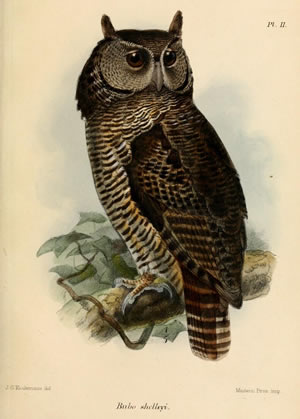The tropical rainforest canopy is the hunting ground for eagle-owls and wood owls.
Owls have large heads and flat faces. Their eyes face forward, so they have stereoscopic vision.
They can turn their heads at least 180 degrees
Unlike other birds of prey, owls have well-developed auditory powers. They use their hearing to locate their prey.
Owls' ears are often asymmetrical. Owls can analyze the differences in the strength of sound collected by each ear and use this information to find their quarry.
Although they are not fast fliers, owls have large wings cushioned with soft, downy feathers that make their flight noiseless and allow them to take victims by surprise.
Eagle-owls
 Eagle-owls are the largest owls of the rainforest.
Eagle-owls are the largest owls of the rainforest.
The tropical rainforests of Africa contain several species of eagle-owl. The largest, Shelley's eagle-owl, Bubo shelleyi, is about 2 feet (60cm) long. Its plumage is barred, making it difficult to see in the dim, dappled light of the rainforest canopy.
Fraser's eagle-owl, Bubo poensis, which can be up to 18 inches (45cm), has an orange-yellow face.
The Akun eagle-owl, Bubo leucostictus, is similar in size to Fraser's eagle-owl but has a weaker build. It is mainly insectivorous.
Unlike most eagle-owls, which have brown feathers, the Philippine eagle-owl, Bubo philippensis, has dark orange feathers above and paler ones below.
Wood Owls
The tropical rainforest is home to several other types of owls that are collectively known as wood owls.
These include the spectacled owl, a wood owl which lives in the Amazon rainforest. The spectacled owl eats small mammals and large insects. It ranges from16 to 19 inches (40 to 48cm) long.